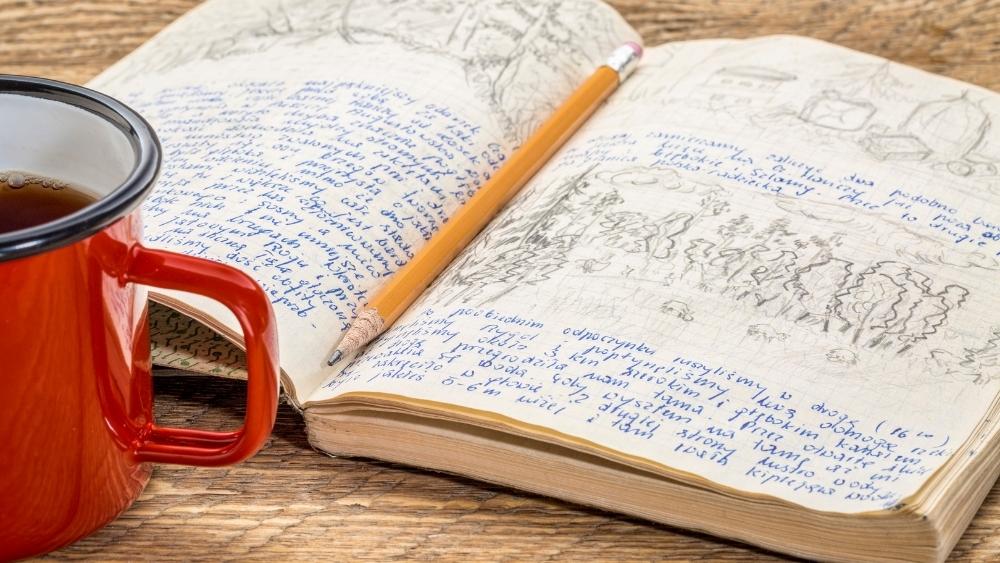Top 17 Journaling Ideas That Will Change Everything
In today’s fast-paced world, finding an outlet for self-expression and personal growth is more essential than ever. Journaling has emerged as a powerful way to explore our thoughts, emotions, and aspirations in both creative and structured ways.
With 17 best journaling ideas from gratitude lists to art journals waiting for you in this blog post, there is something for everyone on their journey towards self-improvement.
Drawing inspiration from numerous articles packed with prompts and techniques, we’ve curated an exciting list of activities that cater to beginners as well as seasoned practitioners.

17 Best Journaling Ideas
Here are 17 of the best journaling ideas that will help you explore your mind:
1. Gratitude Journaling
Embarking on a gratitude journaling journey can transform your perspective and enhance your overall well-being. Here are some effective ways to cultivate the habit of gratitude journaling:
- Start by listing three things you’re grateful for each day – this simple practice helps develop an attitude of gratitude.
- Incorporate morning and evening prompts for daily gratitude journaling, as outlined in the article’s 66 templates and ideas.
- Choose from the 151 gratitude journal prompts provided in the article to spark thankfulness within your daily writing sessions.
- Experiment with different formats, such as numbered lists or bullet points, to keep your journaling fresh and engaging.
- Use the 22 fantastic gratitude prompts listed in the article for diving deeper into specific aspects of your life that you may not have considered before.
- Dedicate a page or section of your journal specifically for reflecting upon how practicing gratitude has impacted your emotional health and mental well-being.
- Jot down inspiring quotes about gratitude that resonate with you, serving as reminders to maintain a positive outlook throughout the challenges of everyday life.
- Share memories of kindness shown to you by others, which can help reinforce feelings of appreciation towards those special people in your life.
- Note moments when you’ve experienced growth and progress, acknowledging how these experiences have contributed to making you a happier person.
- End each week with a roundup of highlights – this can serve as both motivation and inspiration moving forward.
Remember that there’s no right or wrong way to keep a gratitude journal – it’s all about finding what works best for you personally while continually striving for self-improvement through reflection and mindfulness.
Gratitude journaling is a popular practice that involves regularly writing down things you are thankful for.
2. Stream Of Consciousness Writing
Diving into the world of journaling can be a truly transformative experience, and one approach that you might find incredibly liberating is stream-of-consciousness writing.
This method allows you to explore your thoughts freely, jotting them down as they meander from one topic to another without any limitations or boundaries.
To begin practicing stream-of-consciousness writing, start with a simple breath meditation that helps clear your head and invites inspiration. Then, let your pen flow across the page as ideas pop into your brain – don’t worry about grammar, punctuation, or even making sense! The beauty of this technique lies in its lack of rules; it’s all about letting your thoughts spill out onto paper like an uncorked bottle releasing pent-up emotions and untapped creativity.
As a result, not only will you have decluttered your busy mind but also generated fresh insights which can potentially lead to powerful breakthroughs in various aspects of life.
3. Bullet Journaling
Bullet journaling is a fantastic way for you to organize and prioritize various aspects of your life, making it one of the best journaling ideas out there. As a curious person looking to improve yourself, this method allows you to combine planning, task management, goal setting, habit tracking, and personal reflection all in one notebook.
For example, if you’re a college student aiming to ace your classes and stay on top of your study habits, bullet journals can help streamline your academic life by keeping track of deadlines and exam dates or organizing notes from lectures.
Likewise, if managing depression or anxiety symptoms is important for maintaining emotional health, incorporating mood trackers into your bullet journal could give insights into patterns and triggers while providing an outlet for daily self-reflection.
And speaking of versatility – minimalist bullet journals cater perfectly to those who prefer simplicity over artistic elaboration; pastel colors emphasizing functional layouts rather than decorative designs mean clarity remains front-and-center at all times.
4. Dream Journaling
Dream journaling is an excellent way to tap into your subconscious mind, explore your thoughts and emotions, and uncover the hidden messages delivered through your dreams. To make the most out of this journaling idea, I have created a simple table format for you to follow:
| Date | Dream Description | Emotions Felt | Interpretations and Insights |
|---|---|---|---|
| MM/DD/YYYY | Write a brief description of your dream, focusing on the main events and characters. | Describe the emotions you felt during your dream or upon awakening. | Reflect on possible interpretations and personal insights gleaned from your dream. |
By using this table format, you can easily capture and analyze your dreams, gain a deeper understanding of your emotions, and uncover the hidden messages behind them. Regularly updating your dream journal can lead to personal growth and self-improvement. Happy journaling!
5. Travel Journaling
If you’re planning a trip, then travel journaling is one of the best ways to capture your experiences and memories. There are various travel journal ideas, prompts, and tips available that can help you document your trips in an organized and creative way.
Whether it’s a physical bullet journal or a digital version on your phone or tablet, travel journaling can be enjoyed by all ages – even kids can write about the things they brought on the trip, their meals, and the best parts of their day.
6. Art Journaling
Are you looking for a fun and creative way to express yourself while also exploring new ideas? Have you considered trying art journaling? It’s a fantastic form of self-expression that combines the art of drawing, painting, collaging, and writing in one place.
With just some basic art supplies such as paints, brushes, pretty paper, magazines, pictures, stickers, markers, scissors, and glue – the possibilities are endless.
Art journaling can help spark your imagination with new ideas and creativity by pushing you out of your comfort zone. It allows us to explore our feelings through visual imagery rather than words alone.
Whether it’s doodling on your lunch break or creating an entire page inspired by nature – keeping an art journal can be a powerful tool for improving mental health while discovering new personal insights as well as hobbies along the way.

7. Self-Reflection Prompts
Let’s talk about some self-reflection prompts that can help you grow and become a better version of yourself. Here are some ideas:
- Reflect on your strengths and weaknesses. What are some areas where you excel, and what are some things you could improve on?
- Think about a recent challenge or obstacle you faced. How did you handle it? What did you learn?
- Consider your relationships with others. Who are the people in your life who bring positivity and joy? Who might be holding you back or causing stress?
- Write down your short-term and long-term goals. Think about what steps you need to take to achieve them.
- Reflect on your values and beliefs. Are there any that have changed over time? Are there any that you want to prioritize more in your life?
- Consider how you spend your time each day or week. Are there any habits or routines that don’t serve you well?
- Write about a recent accomplishment or success you had, big or small.
Reflecting on these prompts regularly can help increase self-awareness, improve decision-making, and foster personal growth. Give it a try!
Some popular self-reflection journal prompts include identifying things that make you feel calm, powerful, and in control, reflecting on past decisions, and exploring personal qualities and growth.
8. Relationship Journaling
One of the best ways to improve any relationship is through journaling. I’ve found that whenever my partner and I hit a rough patch or just want to deepen our connection, we turn to our couple’s journal.
Some prompts we use include writing love letters to each other, expressing gratitude for one another, and reflecting on past experiences together. It’s amazing how much easier it is to communicate when you’re writing your thoughts down instead of trying to express them verbally at the moment.
Relationship journaling has also helped us learn more about ourselves and what we need from each other in order to feel fulfilled and happy in our partnership.
9. Personal Growth Journaling
Personal growth is an essential aspect of self-improvement, and journaling can serve as a powerful tool to keep track of your progress and goals. The following table offers various journal prompts to guide you in your personal growth journey.
| Topic | Prompt |
|---|---|
| Strengths & Weaknesses | Identify three strengths and three weaknesses. How can you harness your strengths and address your weaknesses? |
| Values & Beliefs | Describe your core values and beliefs. How do they shape your choices and overall life? |
| Challenging Your Comfort Zone | Write about a time when you stepped out of your comfort zone. What did you learn from the experience? |
| Setting Goals | Set three SMART goals (Specific, Measurable, Attainable, Relevant, Time-bound) for the upcoming month. What steps will you take to achieve them? |
| Learning from the Past | Reflect on a past mistake or failure. What lessons did you learn from it and how have you grown since then? |
| Gratitude | Write about three things you’re grateful for today. How do these aspects contribute to your personal growth? |
| Vision Board | Create a vision board in your journal, depicting your goals, aspirations, and values. How will you work towards making these visions a reality? |
Utilize these prompts to inspire self-reflection, evaluate your progress, and motivate yourself to continue growing and improving in your personal and professional life. Embrace the potential for change and watch as you transform into the best version of yourself.
10. Memory Journaling
One of the best types of journaling to help preserve your happiest moments and important events is memory journaling. This type of journaling involves capturing specific memories in detail, from a favorite childhood birthday party to a recent vacation or even just an ordinary day that was particularly memorable.
Memory Journaling allows you to revisit those happy moments and can be especially helpful when dealing with stress or anxiety. By recalling these special moments, you can train your mind to focus on the positive aspects of life and appreciate all the good things around you.
11. Career And Goal-Setting Journaling
Ready to take your career to the next level? Then it’s time to start career journaling. Career and goal-setting journaling is all about reflecting on where you are now, where you want to be, and what steps you need to take in order to get there.
To get started with career and goal-setting journaling, consider using prompts like “Where do I see myself in five years?” or “What skills do I need to develop in order to reach my goals?” You can also use your journal to track your progress toward specific milestones or deadlines.
12. Book And Movie Reviews
As a fellow journal enthusiast, I always find writing book and movie reviews in my journal to be incredibly useful. Not only does it help me remember the stories and their lessons, but it also helps improve my writing skills. Here are some ideas to get you started:
- Write a thorough review of your favorite book or movie of all time.
- Compare and contrast a book and its movie adaptation. Which one did you enjoy more? Why?
- Write about a book or movie that surprised you in a positive way.
- Analyze the themes or messages presented in a particular story.
- Write about how a certain book or movie impacted your life or perspective.
- Discuss a character that resonated with you and why.
- Write about how the setting of a story contributed to your overall enjoyment.
- Review the cinematography, visual effects, or sound design of a particular film.
- Share your thoughts on the pacing and structure of a story.
- Write about how reading books or watching movies has influenced your personal growth and development.
Remember, these reviews don’t have to be long or formal – just write down your thoughts and reactions honestly and authentically!
13. Recipe Journaling
One of the most practical and fun forms of journaling is recipe journaling. If you’re a foodie or love to cook, this type of journal can help you keep track of your favorite recipes, experiment with new ones, and document your culinary creations! You can record everything from simple ingredient lists to detailed cooking instructions, helpful tips and tricks, and even photos or sketches of each dish.
For example, you might want to create a specific recipe book just for holiday or seasonal dishes like gingerbread cookies or pumpkin pie.
Or perhaps you could dedicate pages in your existing journal for themed meals like taco Tuesdays or Meatless Mondays.
14. Nature Journaling
Nature journaling is an incredible way to deepen your connection with the natural world and enhance your creativity. It involves recording your memories, feelings, and personal interactions with nature, allowing you to experience growth and self-discovery. Below is a table of various nature journal activities and prompts that you can try, including a few designed to engage children in this enriching practice.
| Activity | Description |
|---|---|
| Nature Walk Observations | Take a walk in nature, and write down what you see, hear, smell, and feel. Be specific and take note of any changes in your surroundings. |
| Botanical Sketches | Sketch plants, flowers, or trees that catch your eye. Record their names, if you know them, and any special characteristics. |
| Wildlife Tracking | Look for signs of wildlife, like tracks, scat, or nests. If you find any, draw them and note any observations or thoughts you have about the animals that might have left them. |
| Weather Journaling | Document the weather each day, including temperature, cloud formations, precipitation, and how it makes you feel. |
| Nature Poetry | Write a poem inspired by something in nature that resonates with you, like a landscape, plant, or animal. |
| Leaf Rubbings | Create leaf rubbings by placing a leaf under a sheet of paper and rubbing a crayon or pencil over it. This is a great activity for children as well. |
| Nature Photography | Take photos of interesting or beautiful aspects of nature and include them in your journal alongside your written observations. |
| Moon Phases | Track the moon phases each month, and reflect on how they might be influencing your mood or energy levels. |
Embrace the creative aspect of nature journaling by using the activities and prompts above as inspiration. You can even compile your own nature journaling binder containing a collection of journaling styles and activities that you find most meaningful. Remember, the key to successful nature journaling is to be open, receptive, and willing to explore your feelings and connections with the natural world.
15. Daily Affirmations
If you’re looking to improve your mindset and overall well-being, daily affirmations could be just the thing you need. Here are some powerful affirmations to start your day off right:
- I believe in myself and my abilities.
- I am worthy of love and respect.
- I choose happiness and positivity in every moment.
- I trust that everything happens for a reason and always works out for my highest good.
- I am grateful for all the blessings in my life, big and small.
- I release all negative thoughts and emotions, allowing space for peace and joy.
- I am confident and capable in achieving my goals.
- I embrace change as an opportunity for growth and learning.
- I am surrounded by supportive, loving people who uplift me.
- My body is strong, healthy, and capable of anything.
Incorporating these affirmations into your daily routine can help shift your perspective and cultivate a more positive mindset. Try repeating them to yourself each morning or whenever you need a boost throughout the day. Remember: your thoughts create your reality, so choose the ones that serve you best.

16. Financial Journaling
If you want to improve your finances, journaling is a powerful tool. Here are some financial journaling ideas to help you get started:
- Money Goals – Write down your short-term and long-term financial goals.
- Daily Expenses – Track all of your daily expenses so you can identify where you can cut back.
- Income Tracker – Keep a log of all of your income sources.
- Savings Tracker – Track how much money you are saving each month to reach your goals.
- Debt Tracker – Keep track of how much debt you have and create a plan to pay it off.
- Budget Planning – Create a budget plan for the month or year ahead.
- Financial Affirmations – Write down positive affirmations about your financial situation to manifest abundance and prosperity.
- Spending Challenges – Challenge yourself to not spend any money on unnecessary purchases for a certain period of time, like a week or month.
- Investment Ideas – Write out investment ideas that interest you and do research on them.
- Retirement Planning – Plan for retirement by setting concrete steps with deadlines as well as estimating what retirement may look like by using retirement calculators online
- Expense Reduction Strategies – Strategize on ways to reduce everyday expenses while still living the kind of life that you want
- Passive Income Generation – Brainstorm ideas for passive income generation streams
- Money Mindset – Challenge limiting beliefs around money through journal prompts specifically designed for this purpose
- Financial Education – Record valuable information from personal finance books or blogs that could be useful in upping personal knowledge on money management
- Emergency Fund Goal Setting – Set an emergency fund goal, then use tracking methods such as apps and charts to watch progress toward it
- Reflection – Reflect at the end of each month, quarter, or year on successes, shortcomings, and next steps moving forward
- Joyful Spending Bucket List – Create a running list of dream purchases and experiences to save for and enjoy once reached.
17. Mindfulness Journaling
Mindfulness journaling is a powerful tool to improve your mental health and overall well-being. By intentionally focusing on the present moment, you can reduce stress and anxiety, increase self-awareness, and cultivate gratitude.
There are numerous prompts and exercises that you can use to incorporate mindfulness into your journaling practice. For example, you might try stream-of-consciousness writing or free-form drawing without judgment or editing.
Another idea is to create a daily gratitude list where you write down three things each day that you’re thankful for.
As someone who has struggled with anxiety in the past, I’ve found that incorporating mindfulness practices into my journaling routine has been immensely helpful for managing my symptoms.
One of my favorite prompts is “noticing without judgment,” which involves simply observing my thoughts as they arise without trying to change them or analyze them too much.
This exercise helps me stay grounded in the present moment instead of getting caught up in worries about the future or regrets about the past.
Tips For Successful Journaling
Set a regular schedule for journaling, create a comfortable and private writing space, experiment with different prompts and styles, and let go of perfection and grammar concerns to make the most out of your journaling practice.
Setting A Regular Schedule
One of the most important tips for successful journaling is setting a regular schedule. This doesn’t mean you have to write every day, but it does mean creating a routine that works for you.
Setting aside specific times to journal can help make it a habit and an integral part of your self-care routine. It also allows you to reflect on different aspects of your life throughout the week and record any insights or changes.
Personally, I find that writing first thing in the morning sets a positive tone for the rest of my day and helps me organize my thoughts.
Creating A Comfortable And Private Writing Space
As someone who loves journaling, I find it important to have a comfortable and private writing space to help me focus and reflect. A cozy corner of your bedroom or a quiet spot in your favorite cafe can be perfect for this purpose.
When setting up your writing space, think about what makes you feel relaxed and inspired – do you prefer natural light or soft lighting? Scented candles, plants, or inspiring quotes on the wall? Once you’ve created your ideal environment, make sure that it’s private enough for you to express yourself freely.
This can mean finding a secluded corner in public spaces or creating a physical barrier between you and any potential distractions at home.
Experimenting With Different Prompts And Styles Table
One of the most exciting things about journaling is that it allows you to experiment with different prompts and styles. I love mixing up my journal entries by trying out new writing exercises, such as stream-of-consciousness writing or listing quotes I find inspiring. By stretching myself creatively in this way, not only am I more likely to stick with my journaling habit, but I’m also gaining insight into different aspects of my life.
For example, when exploring self-reflection prompts, like “What are three things you’ve learned about yourself recently?” or “Where do you see yourself in five years?”, I’m able to consider important decisions and changes ahead of time. Essentially, experimenting with different prompts and styles is what makes journaling such a powerful tool for personal growth and self-discovery. So go ahead – mix it up! You never know where your next great idea will come from.
Letting Go Of Perfection And Grammar Concerns
One of the most common barriers to starting a journaling practice is the fear of not being good enough. Many people worry about making mistakes or not having perfect grammar, which can prevent them from even picking up a pen.
However, it’s important to remember that journaling is not about perfection, but rather about self-expression and reflection.
Studies have shown that journaling can have numerous benefits for mental health, including reducing symptoms of anxiety and depression. By letting go of our need for perfectionism in our writing, we open ourselves up to a more authentic and honest expression of our thoughts and emotions.
Remember that there are no rules when it comes to journaling – you don’t need to write complete sentences or use fancy language.
The power of journaling for mental health is recognized as a way to reduce stress, focus the mind, and organize thoughts.
FAQs:
1. What are some of the best journaling ideas to try out?
Some of the best journaling ideas include gratitude journals, art journals, dream journals, travel journals, and bullet journals. Additionally, you can try themes like mindfulness or self-discovery to facilitate personal growth.
2. Why is journaling beneficial for mental health?
Journaling has been shown to be a helpful tool for managing stress and anxiety by allowing individuals to process their emotions in a healthy way. It can also improve memory function and boost creativity.
3. How often should I write in my journal?
There is no set rule on how often you should write in your journal; it all depends on what works best for you personally. Some people prefer daily entries while others prefer weekly or even monthly summaries of important events and thoughts.
4. Do I need any special supplies or tools for effective journaling?
The good news is that all you really need is a notebook and pen/pencil! However, investing in colored pens/markers/stickers/etc. prompts/books on different topics may help inspire more creative writing sessions.
As well as facilitate organization if using planner-style setups such as bullet journalling systems where customized tracking layouts can help organize schedules or other tracked data points over time, making them easier to manage across multiple platforms simultaneously (e.g., social media + blog).
Conclusion
Journaling is a powerful tool for personal growth and self-reflection. With the 17 best journaling ideas listed above, you can explore different types of journaling such as gratitude journaling, dream journaling, and financial journaling to name a few.
These journaling ideas not only help you reflect on your thoughts and emotions but also allow you to track your progress toward personal goals. Remember that there are no strict rules when it comes to journaling – experiment with different prompts and styles until you find what works for you.
I wish you the best! Fabian.







